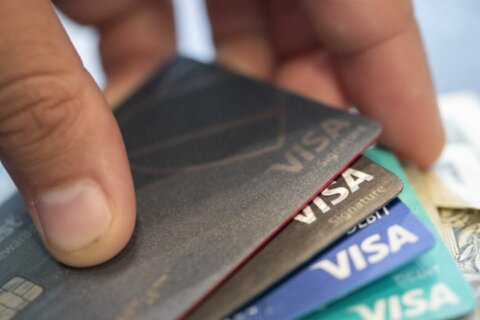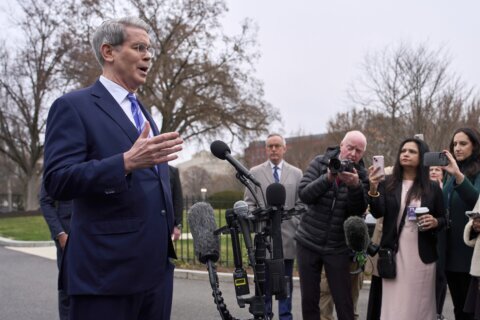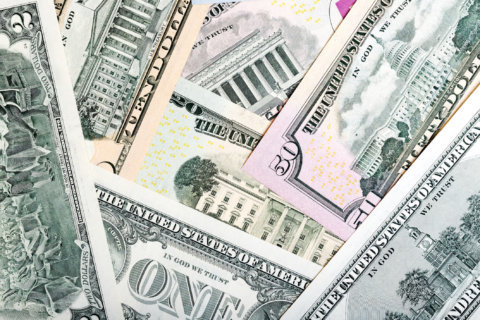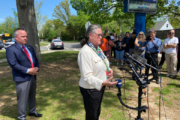For Faustino Vera, falling ill from COVID-19 five times kept him away from his job as a ride-share driver for long periods of time. Without being able to work, he turned to his credit cards to keep the family afloat, using the cards to pay for their home, utilities, groceries and other needs.
Before he knew it, Vera was drowning in debt and felt like the life preserver he was reaching for was getting further and further away. In the end, his debt stacked up to the tune of $40,000.
“Some nights I (did) not sleep because I was very worried about this,” Vera recalled. “I was very worried. I was crying.”
Vera isn’t alone, 48% of Americans carry credit card debt, according to a Bankrate study. For many, shopping and vacations are not what’s putting them in debt — it’s more so due to emergency and day-to-day expenses such as groceries, child care and utilities.
Last year, Vera sought the help of a financial counselor at the city of Gaithersburg’s Financial Empowerment Center. Gaithersburg operates the center in cooperation with the Cities for Financial Empowerment Fund and Housing Initiative Partnership.
John Sanchez is the program manager at the Financial Empowerment Center and said his first step as a financial coach is getting a clear picture of his clients’ financial situation.
“We want to assess your questions, your debt, your concerns,” Sanchez said. “And through the credit report and the financial health assessment, we’re going to figure out what is the best approach to deal with and tackle debt.”
He said one place to begin is building a realistic budget: Know your income, categorize and prioritize your expenses, then allocate how much money you’ll spend in each category. One common strategy is the “50/30/20 rule”: Spending 50% of your income on needs, 30% on wants and 20% on savings and debt repayment.
Next, stay on budget by keeping close tabs on what you’re spending.
“Not everyone loves a spending plan or budget, but at least be mindful where your money goes,” Sanchez said.
He emphasized the importance of changing how his clients see credit cards.
“People just get trapped with their debt because they see credit cards as another type of income,” he said.
He said people should avoid spending more than 30% of their spending limit and should pay off cards as soon as they can.
Leo Elias is the Housing Education and the Financial Empowerment manager at D.C.’s Latino Economic Development Center. He said another debt creator is people turning to “buy now, pay later options” when their credit cards are maxed-out.
“That is also something that’s also very dangerous,” Elias said.
With current debt, Elias said he and his colleagues look first at the accounts a person is paying the most interest on — usually, their credit cards.
“Let’s say you have a credit card of $10,000 and your credit utilization is at 95% — that’s usually the one that we’ll tackle off first,” Elias said.
Elias said it’s not out of the ordinary for someone to be spending $200 or more on interest on a single credit card every month, so tackling those cards first will help make payment plans on other cards more affordable.
Sanchez said other clients need at least some income freed up quickly. For these people, tackling the smallest account and seeing that card go to a zero balance sooner will help get the debt-busting ball rolling.
Both Elias and Sanchez warn of one common mistake they see — canceling credit cards.
“That will lower your credit score,” Sanchez told WTOP.
Sanchez said a person struggling with debt should also look at their car loan if they have one, because some borrowers get charged very high interest rates despite having credit scores above 650 — especially in the immigrant community.
Sanchez said in those cases, they recommend shopping around for refinancing options. He recommends looking into credit unions, which often offer the best rates.
Sanchez said, in some cases, clients can get lenders to work out new payment plans. There are also options to consolidate loans, but he urges people to work with financial coaches on how to do that, since some services that offer consolation options could make things worse.
In dire cases, according to Sanchez, filing for bankruptcy may also be a necessary option, especially if their lenders are already taking them to court over unpaid bills. But the stigma of bankruptcy can make people hesitant to take advantage of this fresh start.
Both coaches encourage their clients not to forget to save for emergencies. Sanchez recommends setting up a separate bank account just for emergencies, and setting up direct deposits so 10% of your income goes directly to that account.
“If you can do that, that will be great, because when the time comes — trust me — if you need it, the money will be there for you,” Sanchez said.
Both Sanchez and Elias urge people struggling with debt to take financial classes offered, that are sometimes free, by many nonprofits and local governments around the D.C. area.
Vera, Sanchez’s client, was forced to file for bankruptcy. But he said his financial coaching sessions also changed how he and his wife look at spending. They now follow a budget, and they have also changed how and when they use credit cards.
Most importantly, he feels he can sleep at night again.
“I am OK. My family is OK. Everything is going OK. We are going up. Now, we are going up,” Vera said.
Get breaking news and daily headlines delivered to your email inbox by signing up here.
© 2025 WTOP. All Rights Reserved. This website is not intended for users located within the European Economic Area.







